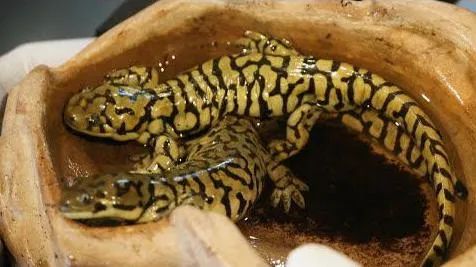
Tiger Salamander
Ambystoma tigrinum
Tiger salamanders earned their name by the striped pattern they have on their back which resemble that of the large cats. As adults, they have thick bodies with generally yellow spots on a black body. Their spots can vary in size, shape, position, and even color. These salamanders are found in North America, ranging from southeastern Alaska east to southern parts of Labrador, and south throughout all the United States to northern and central Mexico. Their populations are not at risk currently, but they are negatively affected by both deforestation and pollution. By absorbing water and air through their skin, they can become at risk of absorbing pollutants and chemicals. Amphibians like these salamanders are considered indicator species because scientists can determine the health of the ecosystem by how their populations are doing; if their population is thriving then so is their environment, and the same sentiment is true in reverse.
Click HERE for a Tiger Salamander Activity Sheet!
Our Current Residents
Simon and Sally were donated to the Zoo by a private individual in 2019 and are in the indoor education building near the gift shop.
Sally, Female- Hatched between May of 2016- May of 2017 (estimated and celebrated)
Sally is larger overall compared to Simon and her stripes are not as dark or thick. She can be found in the dirt, her water bowl, or often sitting on top of Simon.
Simon, Male - Hatched between May of 2016- May of 2017 (estimated and celebrated)
Simon, compared to Sally, is smaller in overall size and has much darker stripes. Simon especially loves to dig and hide, so if you cannot see him, he may be buried under the dirt.
You can get to know Sally and Simon better and meet them in person through our programs scheduled through the Education Department! .
Taxonomy
- Kingdom: Animalia
- Phylum: Chordata
- Class: Amphibia
- Order: Urodela
- Family: Ambystomatidae
- Genus: Ambystoma
- Species: Ambystoma tigrinum
Animal Facts
Carnivores: mainly eat small crustaceans, insect larvae, worms, slugs, snails, etc.
Population Status (according to IUCN): currently listed as Least Concern
Montana Population Status (according to Montana Field Guide): currently listed as Secure
Habitat: forest, grasslands, or marshy areas
Activity: nocturnal- mostly active during the night



















































